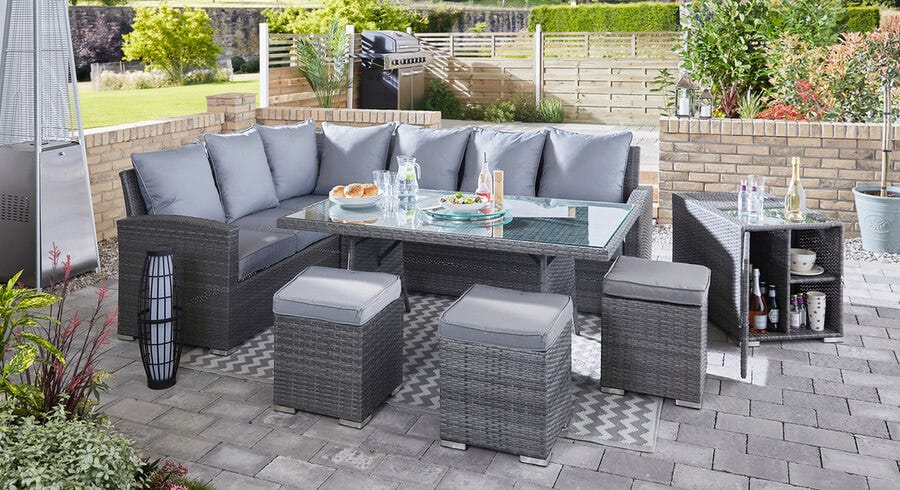The Ultimate Guide To Hot Tub Maintenance


Is there anything more exciting than having your own hot tub? No need to worry about booking in at your local spa or having to wait for spa treats on holidays - simply enjoy bubbly bliss whenever you want in the comfort of your own home, relishing in a little luxury. When you become a new hot tub owner, there are certain steps you’ll need to follow to keep it clean and in safe working order.
We’ve compiled all of the essential elements of hot tub maintenance and care to ensure you’re equipped with all of the knowledge needed to operate and enjoy your home spa safely. Cleaning a hot tub doesn’t need to be a daunting task, once you’re up to speed and have all the cleaning products required, it shouldn’t take up too much of your time weekly.


How to test hot tub water?
Testing your hot tub's water is a vital step to keeping the water clean, safe and healthy. It is recommended that you test the water of your garden hot tub daily as part of your routine whether the spa is in use or not, due to warm water requiring sanitising regularly.
The PH, sanitiser, and total alkalinity levels of the water are what you’ll need to test. The easiest way to do this is by using test strips that will deliver the results quickly and accurately. Remember to always follow the instructions on the bottle carefully to get a precise reading.
pH control
The term pH is a way of determining whether your water is acidic or alkaline. The pH scale works from 0-14 with 7 being neutral. Anything below 7 is classed as acidic, and anything above 7 is considered alkaline.
When reading the results of the test strip, seeing both low and high pH values will mean the water may cause skin or eye irritation, causing uncomfortable bathing. Also, low or high pH values can interfere with the efficiency of the sanitiser (especially chlorine) to control and kill potentially harmful bacteria and pathogens.
A low pH can be corrosive and lead to your hot tub becoming damaged over time while a high pH can be scale-forming leading to cloudy water and scale formation on heating elements and other spa surfaces.
Remember the ideal pH is within the range of 7.2 and 7.8, so if the pH is lower than 7.2 use a pH increaser, and conversely if the pH is above 7.8 use a pH reducer. For those using chlorine as a sanitiser, the ideal pH level is between 7.2 and 7.6 and the ideal level for those using bromine is 7.0-7.4.
TIP: Remember, if the pH level is incorrect you will have problems balancing your sanitiser level, so always adjust your pH level before adding sanitiser.


Sanitiser control
Your hot tub will need to be treated with a sanitiser to control and prevent bacteria growth. There are two sanitisers you can choose to use: Chlorine or Bromine.
Chlorine is a very popular choice due to it being cost-effective and is a very fast-acting sanitiser. You can buy it in granules or tablet form.
Chlorine granules
Sprinkle the granules over the water surface or add the granules by pre-diluting them in a container of warm water before pouring them in. Remember it’s always best to start adding small amounts of chlorine in small amounts (unless the level is very low), to prevent overdosing. Then leave the water for about two hours, before retesting. This will give time for the chlorine to work, so if the water is very dirty, you’ll see all the chlorine will be used up, and you will have another low reading. If the water is properly balanced then a chlorine residual will remain, and no more will need to be added.
Chlorine tablets
Another way of placing chlorine in your hot tub is by putting tablets in a floating dispenser. The advantage of this means that there is chlorine being dispensed constantly, however it gives you less control compared to using granules.
For best results, start by adding three to four tablets and adjusting the dispenser flow as necessary. Simply twist the base to allow water to flow through one hole, two holes, three holes, or four holes. There should always be tablets in the dispenser, so remember not to leave them until they are completely exhausted before replacing them. Re-test the water again in approximately two hours to see if the level has been raised sufficiently.
Bromine
Bromine is the alternative sanitiser to chlorine and comes in granule and tablet formula. It’s more expensive and slow-acting which means it takes longer to show a reading when testing and can result in cloudy water.
However, some benefits include having a slightly softer smell, being much more stable in higher water temperatures and it can regenerate unlike chlorine (meaning you can keep reactivating bromide salts using a shock, reducing your need to add sanitiser). You can use bromine tablets the same way as chlorine tablets. You can also boost bromine levels with bromine granules or by shocking with Non-Chlorine Shock.
Always remember never add water to chemicals, always add chemicals to water!
TIP: These are ideal ranges for sanitiser levels when using a test strip:
- Free Chlorine = 3 - 5mg/l (milligrams per litre)
- Free Bromine = 4 - 6mg/l (milligrams per litre)
Shock treatments
In addition to the preferred sanitiser you use in your hot tub, it’s also recommended to “shock” dose or oxidise your water every week with a non-chlorine shock treatment. It will serve 3 main purposes:
- Break down Chloramines - sanitiser reacts with bather pollutants such as perspiration or dead skin and produces a less effective chemical compound called chloramines which needs to be broken down. Chloramines have a strong chlorine odour that is often mistaken for too much chlorine, and make the water appear cloudy.
- Kill bacteria - some bacteria can become resistant to your sanitiser, so the shock treatment will destroy any remaining bacteria
- Remove organic compounds - people carry organic compounds on their skin, such as dead skin and oils. These can build up in the hot tub and cause cloudy water, so shock treatment will help to remove them.
When to change the water?
Water can only be chemically maintained for so long before it needs replacing. Changing the water in your hot tub should be done ideally once a month. However, If your hot tub isn’t going to be used that much, you only need to change the water once every 3 to 4 months.
Before emptying the water, add a pipe cleaner into your hot tub. This will remove any dirt, residue, or greasy body oils and will also loosen any calcium from the pipework, which will then be washed away with the drained water.
TIP: Don’t forget to remove the headrests if your hot tub has them. Once removed, clean them thoroughly and the acrylic area behind the headrests to remove any potential contaminants.
Hot tub filter cleaning
How regularly should I clean and change the filters?
In order to ensure clean and functioning hot tub filters, there are three timeframes that you need to keep in mind:
- 2 - 3 weeks - It’s recommended you carry out a quick rinse and clean, nothing too time-consuming. You should remove your filter from the pool and rinse it with a garden hose to release larger debris such as hair and leaves that could clog up the filter. Make sure it’s dry before putting back into your hot tub.
- 2 - 3 months - This is when you give the filters a more thorough clean. It’s best to keep a clean filter on hand to replace your dirty one while you carry out the deep clean process. Simply, place your filter in a bucket filled with water. Add no more than 8 ounces of your hot tub filter cleaning solution into the bucket. If your filter is especially dirty, it’s best to add double the amount of cleaning solution. Mix the solution in the bucket by turning and pumping the filter up and down. Allow soaking for 12 – 24 hours. Once, soaking is finished, give it a good rinse with your garden hose to remove any excess chemicals from the solution and allow it to dry before putting it back into your hot tub. Allow the filter to dry for as long as possible as this resets the fibres in the filter, making filtration more effective when the filter is put back into your hot tub.
- Once a year - Filters are designed to last for about a year, more or less depending on use. It’s not a good idea to use your filter for more than 12 months though as the filter can become ineffective and leave debris and bacteria in your hot tub water.
Why is there lots of foam in my hot tub?
If you discover there is a lot of foam appearing on the top of your hot tub water, it can be caused by non-organic products like cosmetics such as deodorant, makeup, and detergents.
One way to avoid a foam build-up is to encourage hot tub bathers to shower with their swimsuits on before getting into the hot tub. This will not only help to remove detergents but will also remove cosmetics and lotions from the body. Also using a Non Chlorine shock will oxidise these non-organic products and dump the particles on your filters.
Another option is to use an anti-foam product in small amounts which can quickly clear the foam from the waterline in the short-term, this is more of a quick fix.
Hot tub maintenance safety tips
As a hot tub owner/user, It’s important to keep these important safety tips in mind:
- Avoid hot tub temperatures that exceed 40℃ (lower when children are in it).
- Never leave non-swimmers / children unattended in a hot tub.
- Don’t allow more people in your hot tub than its recommended size.
- Do not use electrical appliances near your hot tub.
- Avoid using glass around or in your hot tub.
- If you’re pregnant, have high blood pressure, or any cardiovascular conditions please contact your doctor before using a hot tub.
- Always wear gloves when changing hot tub filter cartridges or carrying out general cleaning.












